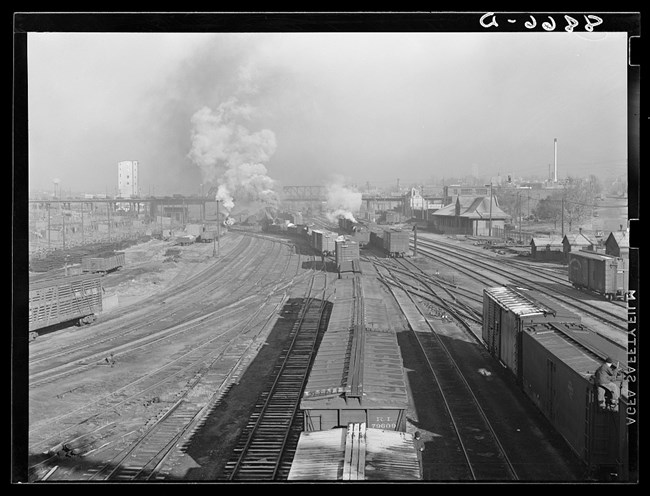Omaha grew due to and continues to serve as a key link to cross-contury travel. To help you learn more about the city's transporation history and the resources related to it, this page is divided into a historical overview, followed by a listing of historic properties that represent the city's transporation history.
Overview

Vachon, John, photographer. Omaha, Nebraska. Railroad yards. United States Nebraska Omaha Douglas County, 1938. Nov. Photograph. https://www.loc.gov/item/2017767973/.
Western expansion, however, was not always a romantic tale. The Pioneer-Mormon Cemetery marks the final resting place of 359 Mormon pioneers who died during the winter spent in Omaha. As dangerous as expansion was for pioneers, it was devastating for many American Indian tribes whose homeland was encroached upon and eventually seized. Western expansion resulted in the forced removal and relocation of many indigenous tribes to land in modern day Oklahoma.
A transportation company, the Council Bluffs and Nebraska Ferry Company, plotted the site of Omaha shortly after the Kansas-Nebraska Act of 1854. By 1860 Omaha had grown to a sizeable transfer point and transportation center with steamboats bringing supplies and travelers across the Missouri while stagecoaches and overland freighters taking people and supplies west.
The history of transportation in Omaha, and the nation, hit a turning point in 1862 when President Abraham Lincoln signed the Pacific Railroad Act providing federal money and land grants for the construction of a transcontinental railroad connecting the east and west coasts. The Act formed the Union Pacific Company, responsible for a branch line that would run from Fort Kearney through Omaha and Council Bluffs. The Union Pacific Company decided Omaha would be the eastern terminus and made the city its base of operations. On May 10, 1869, the rail line from Sacramento, California connected with the Union Pacific Company’s lines from Omaha in Promontory Summit, Utah Territory. By the turn of the nineteenth century, the city boasted two major train stations – Union Station and Burlington Station – along with the Burlington Headquarters Building. The United States Army took advantage of the plethora of rail lines in Omaha and built the Omaha Quartermaster Depot in 1881, serving as a distribution center for military outposts in the West.
Beginning in 1867, streetcar lines paved the way for residential development outside of downtown in cities across the United States. Originally horse drawn systems of cars and tracks, Omaha’s streetcar lines were generally owned and operated by real estate owners looking to make their land more accessible and, therefore, attractive. Streetcar companies moved away from horse-drawn coaches in favor of cable and electric power modes. Ultimately, the electric streetcar system emerged victorious and sparked the transformation of transportation in Omaha. Regardless of how they were powered, streetcars were an effective tool for land speculators to promote their properties outside of downtown Omaha. Regular streetcar service encouraged the construction of residential neighborhoods, especially apartment buildings, toward the end of the nineteenth century. Over the next three decades, streetcar lines streetcars paved the way for development outside of downtown allowing people to move away from the urban core while maintaining access to their jobs. Neighborhoods like Orchard Hill and the Park Avenue Apartment District are evidence of the impact of streetcars on the city.
Growing popularity and accessibility to automobiles ushered in the Auto Age during the early twentieth century. Recognizing the growing popularity of vehicular travel, a group of investors formed the Lincoln Highway Association. In 1913 they planned the first transcontinental auto route from New York City to San Francisco, passing through Omaha. Omaha’s built environment along the highway was highly influenced as transportation-related businesses lining stretches of the route. The Omaha Auto Row Historic District along Farnam and Harney Streets is made up of numerous car dealerships and with service stations and a hotel used by auto travelers.
The Saddle Creek Underpass exemplifies a New Deal transportation project undertaken during the Great Depression of the 1930s. Post-World War II interstate system construction destroyed many historic properties in Omaha, as it did across the entire country, and awakened the nation for the need for a National Historic Preservation Act, which was signed into law in 1966.
The history of transportation is inherent to the story of Omaha. From the city’s inception to the excitement of the transcontinental railroad to the rise of the automobile, transportation shaped the contours and the history of Omaha.
You can find the historic properties under this Story – along with others throughout Omaha – by visiting the Travel Omaha, NE Map.
Omaha's Historic Transportation Resources
Last updated: April 5, 2023
